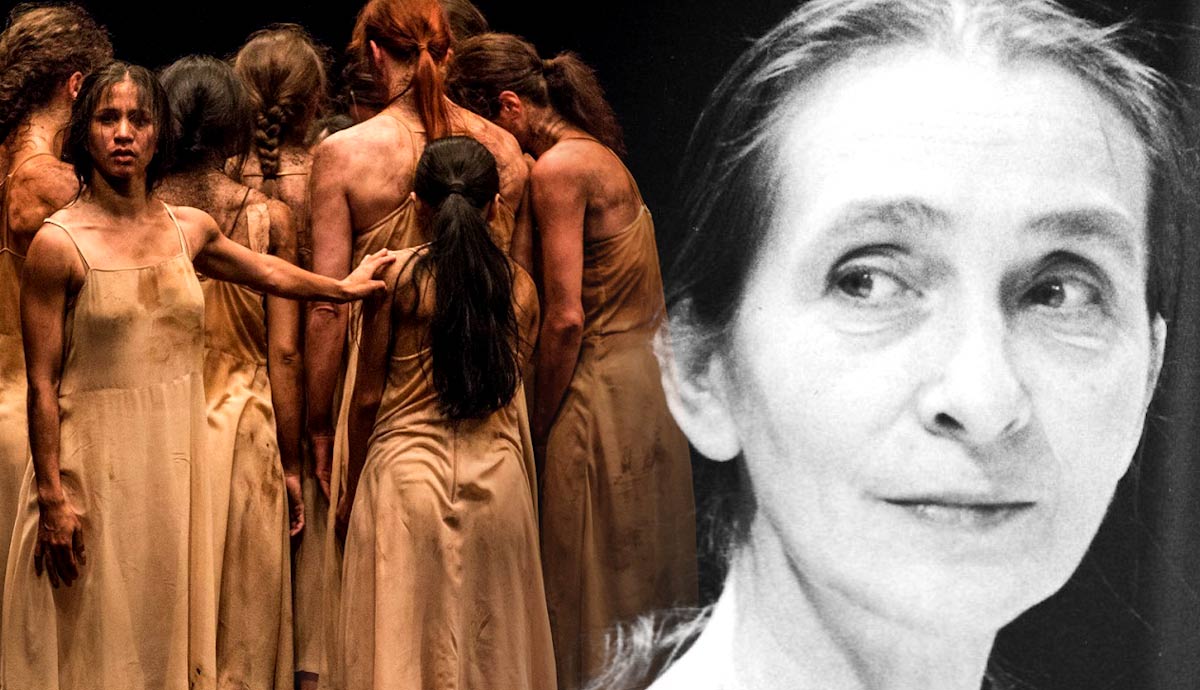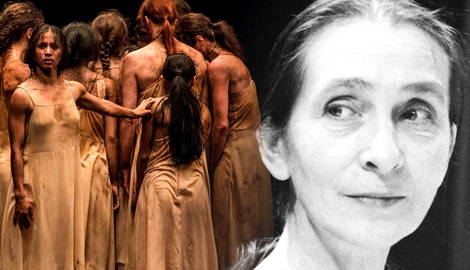
Pina Bausch was born in Solingen, Germany in 1940 as the daughter of two hotel owners. She became a legendary figure in the world of dance, creating a new type of genre that focused on mixing elements of theater and dance. Here are ten interesting facts about the extraordinary artist who invented her very own version of performance called Tanztheater.
1. Pina Bausch Started Studying Dance at 14

Pina Bausch discovered her love of dance very early in life, so she entered the Folkwang Academy in Essen at the age of 14. At the time, the school was run by the influential choreographer Kurt Jooss, one of the founders of Ausdruckstanz— meaning expressive dance. The great choreographer ended up becoming like a second father to her.

The mix of different artistic disciplines she experienced there proved to be very influential. During these early days, nobody could have guessed that Pina Bausch would become one of the most important choreographers of the 20th century. She did show a lot of potential, however. At the age of 19, Pina was invited to study at the renowned Julliard School of Contemporary Dance in New York. At the age of 19, Pina was invited to study at the renowned Julliard School of Contemporary Dance in New York.
2. In New York, She Lived on Buttermilk and Ice Cream

New York proved to be yet another great influence in Pina Bausch´s development as an artist. While studying at the Julliard School of Contemporary Dance, Pina got to learn from the renowned Antony Tudor and José Limon, among others. Unfortunately, her time spent in New York City did not prove to be very good for her health. Like many dancers faced with the pressure of fitting into the fairy-like aesthetic of a dancer’s body, she ended up developing an eating disorder. For a time, she nourished herself mostly by mixing together nut-flavored ice cream with buttermilk, lemon, and sugar.
According to Pina Pausch herself, her strange food choices weren´t due to anorexia. Instead, she claimed that she was simply trying to save money. Pina Bausch also felt that as she was getting thinner, something inside her was getting purified. It was almost as if eating less was helping her find her inner voice. Whether it was an eating disorder or not, one fact remains true—she lost a lot of weight and the people around her started to get worried.
3. She Wanted to Develop Her Own Movement Language

Once she was back in Germany, Pina’s eating habits seemed to have normalized, and she started working as a dancer and choreographer’s assistant in the company of Kurt Jooss. But this wasn’t enough for her. Pina wanted to develop her own pieces. Unlike many of her peers working within pre-existing styles, she started looking for her own movement language. She tried to find her own way of expressing what was inside her heart. But as she quickly found out, her novel ways of working were not exactly what the typical German dance audience was looking for.
4. She Took Over the Tanztheater Wuppertal

When Pina Bausch was invited to take over directorship of the local dance company in the German town of Wuppertal, she started creating performances that did not fit into the audience’s expectations of what dance should look like. Instead, she was creating a new type of avant-garde performance that brought together elements of dance, theater, opera, and music. The audience was not too happy about this at first. They simply wanted to see what they had grown used to. What followed were walk-outs and complaints from the audience.
The first years were very difficult. Again and again spectators would leave the auditorium slamming doors, while others whistled or booed, the choreographer remembers. But despite the backlash, Pina and her troupe continued searching for new ways of expression. Her persistence ended up paying off. Today, the choreographer and her Tanztheater Wuppertal are known across the entire world.
5. She Created a New Performance Style Called Tanztheater

After the collective trauma of World War II, many of the old ways of making art were no longer making sense. As artists searched for new forms of expression, they started going beyond the classical ways of dancing. Pina Bausch ended up being one of the pioneers of a movement that came to be known as Tanztheater, which brought together elements of dance, theater, opera, and music. But what made Bausch´s work unique, wasn’t just that she refused to stick within the boundaries of classical dance.
She also created her own poetic way of storytelling that did not follow a traditional plotline. Instead, she created a tapestry of different scenes that were usually focused on the bittersweet reality of human relationships and human existence. Her works often included the painful repetitions of the same actions, words, and movements. In her performance Café Mueller, for example, you see a woman jumping into a man’s arms repeatedly, while another woman (played by Pina herself) blindly runs against the walls.
6. She Liked to Start Rehearsals with Questions

The traditional way of creating a theater or dance piece usually involves the existence of a text or score that serves as the basis for the piece. At the time, it was normal for directors or choreographers to start the first rehearsal with a pretty solid idea of what the choreography and staging should look like. While Pina Bausch tried this approach at the beginning of her career, she soon developed an alternative rehearsing method. Instead of planning out the performance in advance, she would give the performers she worked with a set of questions, to which they had to create performative answers. Using this material as a starting point, she would then weave together the performance. Pina Bausch’s creative use of questions also points to the choreographer’s interest in diving deep into the human psyche. One of her most-quoted sayings is: “I am not interested in how people move, I am interested in what moves them.”
7. Her First Husband Died Young

Pina Bausch´s first husband Rolf Borzik was also her closest artistic collaborator. During their years of working and living together, Rolf was constantly by her side as her set and costume designer. Together, they created poetic landscapes, using real materials like soil and water or simple elements like chairs. But their collaboration was not meant to last forever. Rolf Borzik died in 1980, at the age of 35. Her husband’s early death was a huge blow to the choreographer, but she did not let that stop her from making art. Instead, she decided to process her grief by creating her seminal piece 1980. Following the death of her husband, she started working with a set designer called Peter Pabst. Later on, she met the Chilean artist and poet Ronald Kay, whom she ended up marrying and having a child with.
8. She Created a Series of Performances Based on Different Cities

As Pina Bausch and her Tanztheater Wuppertal group started to become known and loved in the international art scene, they were invited to create performances in different cities around the world. This led to the creation of the World Cities series which consisted of pieces that were created in and inspired by cities like Los Angeles, Rome, and Budapest. The resulting pieces include a performance called Viktor (created in Rome), The Window Cleaner (created in Hong Kong), and Àgua (created in São Paolo).
9. She Was a Complete Workaholic

Although Pina Bausch’s appearance seems very frail and soft, she was known to be a workaholic. The choreographer was known to live on black coffee and cigarettes, pouring everything she had into whatever performance she was working on. She was also known to be extremely nervous throughout the entirety of the rehearsal process. Given that she started every new piece with nothing but a set of questions and a premiere date, this is hardly surprising.
Her partner Ronald Kay revealed in an interview with the Guardian: “She works in the rehearsal room from 10 in the morning, and rehearsals don’t end till late in the evening. We eat, and then she sits there till two or three o´clock getting an idea of what it was all about, what can be kept, what are the little jewels of the piece. And then she gets up at seven, sometimes even earlier, to prepare. She always manages to keep the same intensity.”
10. Pina Bausch Died of Cancer in 2009

Unfortunately, Pina Bausch’s love of cigarettes was also one of the causes of her early death. On the 30th of June in 2009, the great choreographer died of lung cancer at the age of 68. She had only received the diagnosis 5 days prior, and the shooting for a Wim Wenders documentary about her was scheduled to start within a few days. While the choreographer’s sudden death left the dancers of Pina Bausch’s company devastated, they convinced Wim Wenders to move forward with the project nevertheless. The resulting work carries the title Pina and is one of the most beautiful dance-films of all time.










